  February 1—February 28, 2016 at Woolly Mammoth 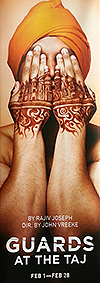 By Rajiv Joseph Directed by John Vreeke India, 1648: two
imperial guards watch as the sun rises over the newly-completed Taj
Mahal, an awe-inspiring monument to the emperor's dead queen. But awe
gives way to terror when the guards are given a new assignment: to
perform a bloody task whose grisly aftermath will force them to
question the very ideas of beauty, responsibility, and friendship.
"With Gruesome Playground Injuries still fresh in our minds, we're so happy to welcome back Rajiv Joseph to continue his partnership with John Vreeke here at Woolly," says Woolly Mammoth Artistic Director Howard Shalwitz. "Guards at the Taj may appear to take place in a world far removed from modern day Washington, DC, but in its depiction of a deep friendship pitted against the horrific inequities of an empire, it hits remarkably close to our current obsessions in the nation's capital." |
|
Reviews and Photos: [Photos by Scott Suchman] |
Black comedy turns to horror in ‘Guards at the Taj’ Review by Nelson Pressley Washington Post The two simpletons yakking on the job seem awfully familiar. Talking about how they are not supposed to be talking, they are Abbott and Costello doing “Who’s on first?” Philosophizing as they rather pointlessly stand watch (they are guards), they are the tramps in “Waiting for Godot.” Caught in political machinations way above their pay grade, they are the doomed bit players in “Rosencrantz and Guildenstern Are Dead.” 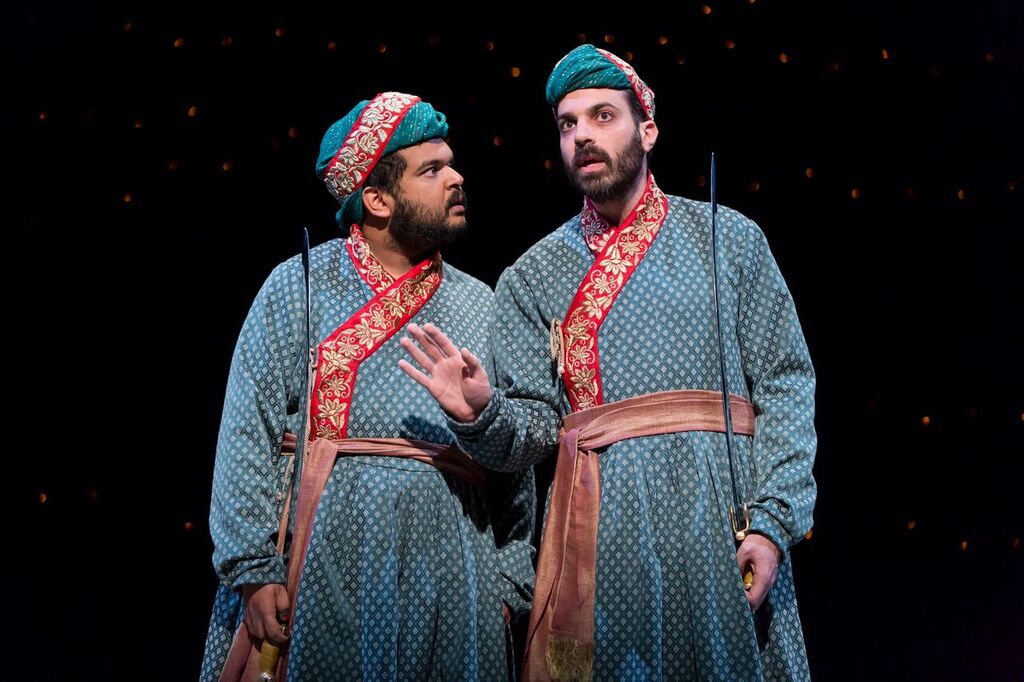 If Rajiv Joseph’s
“Guards at the Taj” leaves you with a nagging feeling that you haven’t
seen anything new, that may be why. On the other hand — and that’s a
rich transition, once you know the shock-value twist Joseph has up his
sleeve — “Guards” turns out to be a rather ingenious piece of theater If Rajiv Joseph’s
“Guards at the Taj” leaves you with a nagging feeling that you haven’t
seen anything new, that may be why. On the other hand — and that’s a
rich transition, once you know the shock-value twist Joseph has up his
sleeve — “Guards” turns out to be a rather ingenious piece of theaterThe design of the Woolly Mammoth Theatre Company production is fiendishly good, evoking the transcendence of the brand-new Taj Mahal in 1648 while also graphically rendering a brutality that’s often kept out of sight. Joseph (“Bengal Tiger at the Baghdad Zoo”) suggests that there is a hidden human cost to civilization’s vanities and purported glories. That’s what his hapless guards learn. Mind you, this is not an opulent show. Director John Vreeke mainly uses a bare stage as Humayun (the obedient guard) and Babur (the naive, questioning sidekick) stand and babble in the dark. They are forbidden from turning their heads around to behold the magnificent new structure that’s finally ready to be unveiled after years of hushed construction. The chatty Babur wonders why they shouldn’t look. Babur, played with childlike wonder and dogged curiosity by Kenneth De Abrew, asks a lot of questions that unnerve Humayun (Ethan Hova, always slightly frightened). The guards talk in a slangy and profane modern way. Their situation is messed up.  Misha Kachman’s set
is a platform that juts into the audience with a simple starry sky in
back, courtesy of Jen Schriever’s lights. It’s pretty much just two
actors on a bare stage, yet the performance blossoms into something
strikingly sensual. It would spoil things to explain how, for the play
depends on surprises that are almost all visual. But it’s fair to say
that Schriever’s lights and Palmer Hefferan’s sound wonderfully match
the suggestion in Rajiv’s dialogue, creating a sense of awe for
something you never quite see. Misha Kachman’s set
is a platform that juts into the audience with a simple starry sky in
back, courtesy of Jen Schriever’s lights. It’s pretty much just two
actors on a bare stage, yet the performance blossoms into something
strikingly sensual. It would spoil things to explain how, for the play
depends on surprises that are almost all visual. But it’s fair to say
that Schriever’s lights and Palmer Hefferan’s sound wonderfully match
the suggestion in Rajiv’s dialogue, creating a sense of awe for
something you never quite see.The flip side is the gruesome hellscape depicted by Kachman and costume designer Frank Labovitz. Humayun and Babur are condemned to execute a ruthless order, and their new workspace is intense and bloody, with a substantial ick factor. The juxtaposition of gorgeous implication with gritty reality makes its point. Joseph’s theme is beauty; that’s what Babur obsesses about as his gaze is forced into the muck. At times the argument sinks into melodrama about corrupt power and hapless victims, but theatrically the show is awfully enterprising. De Abrew and Hova are expansive and personable as Babur and Humayun, dispensable figures in a human comedy that darkens and grows like a black hole. The pictures they are in are worth a thousand words. Review by Nelson Pressley Washington Post |
|
Review
by David Gerson
Although it is never seen, not even a glimpse of one of its four minarets or gleaming domes, the Taj Mahal looms large as a monument of beauty and death as it haunts Rajiv Joseph’s poetic morality play Guards at the Taj, which is being given a stunning and soulful production directed by John Vreeke at Woolly Mammoth Theatre in Washington, DC. The Taj Mahal was commissioned in 1632 by Emperor Shah Jahan to house the tomb of his wife, who died during childbirth. The principal construction was completed in 1643 and the entire project, including gardens and ancillary buildings, were completed in 1653. The entire project is estimated to have cost 32 million rupees (today, about $827 million US) and required the labor of 20,000 workers. 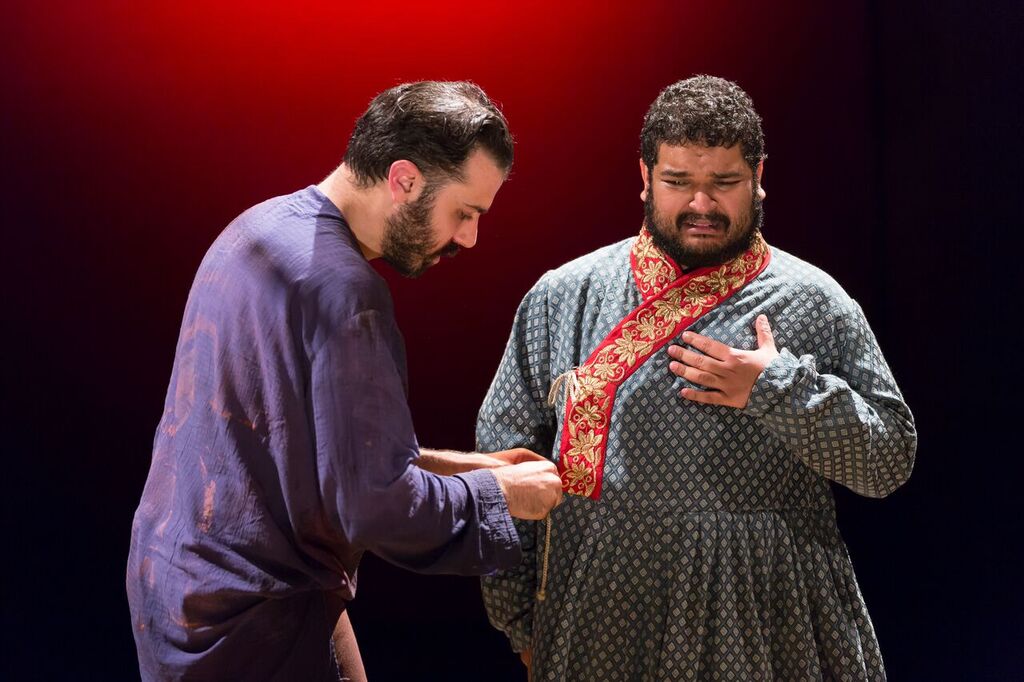 Joseph’s play is set
in 1648, when it is said that the building was finally unveiled, and
opens on the perimeter of the great structure where Humayun (a nuanced,
complex performance by Ethan Hova) and Babur (a comical and fiery
Kenneth De Abrew), the lowliest guards at the Taj, stand watch and are
threatened with punishment for the smallest infraction, like holding
their sword on the wrong side, speaking while on duty or, daring to
turn and glimpse the beautiful mausoleum, in its most glorious
splendor, as the sun reveals it at the break of day. Joseph’s play is set
in 1648, when it is said that the building was finally unveiled, and
opens on the perimeter of the great structure where Humayun (a nuanced,
complex performance by Ethan Hova) and Babur (a comical and fiery
Kenneth De Abrew), the lowliest guards at the Taj, stand watch and are
threatened with punishment for the smallest infraction, like holding
their sword on the wrong side, speaking while on duty or, daring to
turn and glimpse the beautiful mausoleum, in its most glorious
splendor, as the sun reveals it at the break of day.Humayun is a man of duty and allegiance who believes that work and loyalty will not only bring opportunity and reward, but also survival in a society ruled by a totalitarian regime. His foil is Babur, a dreamer, a man guided by a sense of wonder and beauty, unaware of, or, perhaps, unwilling to acknowledge the smallness of his value in a world where his life means so little. Early in the play in the play Babur cranes his head skyward and asks with wonder what the stars, these “celestial illuminations” mean. Humayun replies with indifference, that they are “determinations of our fates and fortunes.” Where Humayun is guided by the pragmatic idea that our fate is predetermined, Babur represents the dream that anything, no matter how improbable, even being assigned to guard the emperor’s harem, is possible! 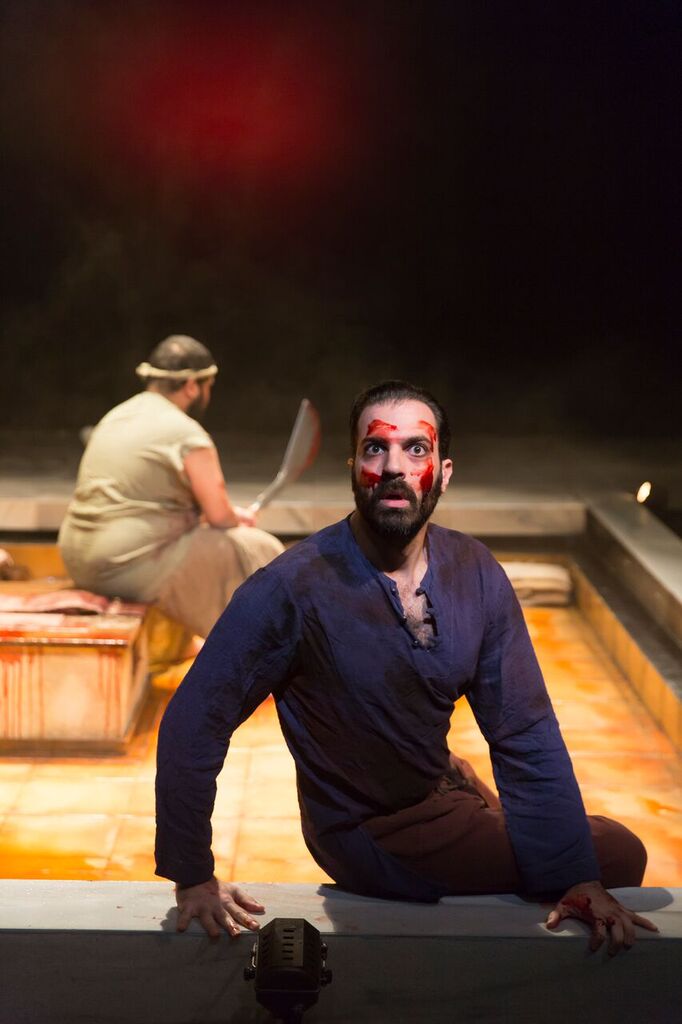 When word comes down that the Emperor has decreed that nothing as beautiful as the Taj Mahal can ever be built again and to ensure this, he orders the behanding of all 20,000 men who built it, the gruesome task falls to Humayun and Babur. As the two men realize the weight of what lies before them and they go to accept this duty, they turn their backs to the audience and in an extraordinary coup de theatre, the music swells (the dramatic sound design is by Palmer Hefferan), the lights rise from a dim to a white hot blaze, the guards stagger and drop their swords in awe at the forbidden beauty of the Taj in the morning light (here a blank scrim) as the slick marble floor of Misha Kachman’s cool, sparse, contemporary set slides open to reveal a smoking bloodied tiled pit. Joseph and Vreeke spare us much, but not all, of the gore. Humayun and Babur are promoted for doing such a good job. Humayun reminds Babur that “we do not always get pleasant tasks, but we work our way to more pleasant tasks.” Babur is traumatized, not only by the butchering he performed the night before, but because by doing so, he has destroyed beauty and condemned it to extinction. He concocts a plan to resurrect it, one that will surely bring about his and Humayun’s death. In Guards at the Taj, Joseph asks us to consider whether it is more important to live or whether it is more important to not die. It may seem, on its face, that these things are indistinguishable, but Joseph shows us that they stand in stark contrast to each other. Babur desires life, to be a part of a world larger than his station and to leave behind beauty to manifest for generations. Humayun is a cog in a machine, his avowed goal, to not die, guides his choices, no matter how morally reprehensible. When Babur laments that he killed beauty as he plans his own martyrdom, Humayun, tries, but cannot fully take responsibility as a co-conspirator, because he is unable to hide his true nature and mask his own weakness. The play is not some museum piece for us to ponder about a legend almost 400 years old, however. These themes have been doomed to repeat themselves throughout modern history. How many times has suffering been caused by following orders, regardless of the direction of one’s moral compass, either on a massive scale (the Holocaust) or miniscule (performing a task at work, you take moral issue with so you didn’t lose your paycheck)? Joseph connects his play to the present by having his characters speak in contemporary language.  These links are
further tightened by the intelligent work of Vreeke’s design team: the
aforementioned set design by Ms. Kachman that reconfigures the Woolly
space to surround the audience making us not only observers to the
action, but complicit in it; the clinical, almost laboratory-like
lighting design by Jen Schriever; and the traditional, elegant costumes
by Frank Labovitz which, when juxtaposed with the modern set and
lighting give the production the feeling of an anthropological study. These links are
further tightened by the intelligent work of Vreeke’s design team: the
aforementioned set design by Ms. Kachman that reconfigures the Woolly
space to surround the audience making us not only observers to the
action, but complicit in it; the clinical, almost laboratory-like
lighting design by Jen Schriever; and the traditional, elegant costumes
by Frank Labovitz which, when juxtaposed with the modern set and
lighting give the production the feeling of an anthropological study.Mr. Joseph gives us a beautiful coda before the stage goes dark. It’s disorienting at first, and it takes a few moments to realize what’s happening. Suffice it to say, each character finds what they say they want in the end. And we are reminded that, no matter the cost, not dying is no way to live a life. Review by David Gerson DC Theater Arts |
|
Woolly’s production of Guards at the Taj
takes us into the
heart of every person who has stood before the vanity of institution
and empire and been told “to follow orders.”
Review by Robert Michael Oliver DC Theater Arts 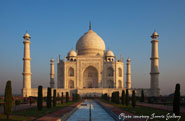 Rajiv
Joseph’s Guards at the Taj, now playing at Woolly Mammoth Theatre
Company, provokes its audience with grand flamingo visions, with
horrific buckets of blood, with aesthetic debate on the role of art in
society, with the Nuremberg Defense (“I was just following orders.”) or
maybe its democratic equivalent (Majority Rule). Rajiv
Joseph’s Guards at the Taj, now playing at Woolly Mammoth Theatre
Company, provokes its audience with grand flamingo visions, with
horrific buckets of blood, with aesthetic debate on the role of art in
society, with the Nuremberg Defense (“I was just following orders.”) or
maybe its democratic equivalent (Majority Rule).In Guards at the Taj, playwright Joseph takes us to Hindustan, circa 1650, to the grand opening (or unveiling) of the Taj Mahal, one of the greatest architectural and artistic achievements in human history. Two young men are assigned guard duty. They are to stand motionless and speechless before the Taj’s majestic aura. The problem: one of the young men, Babur (Kenneth De Abrew) cannot keep his mouth shut. By the way, Babur shares his name with the founder of the Mughal Dynasty (actually the Timurid Empire whose roots go back to the Mongol Empire of Ghengis Khan). He also cannot stay still, or even arrive on time. Obviously, he shouldn’t have become a soldier, but considering the job market…. 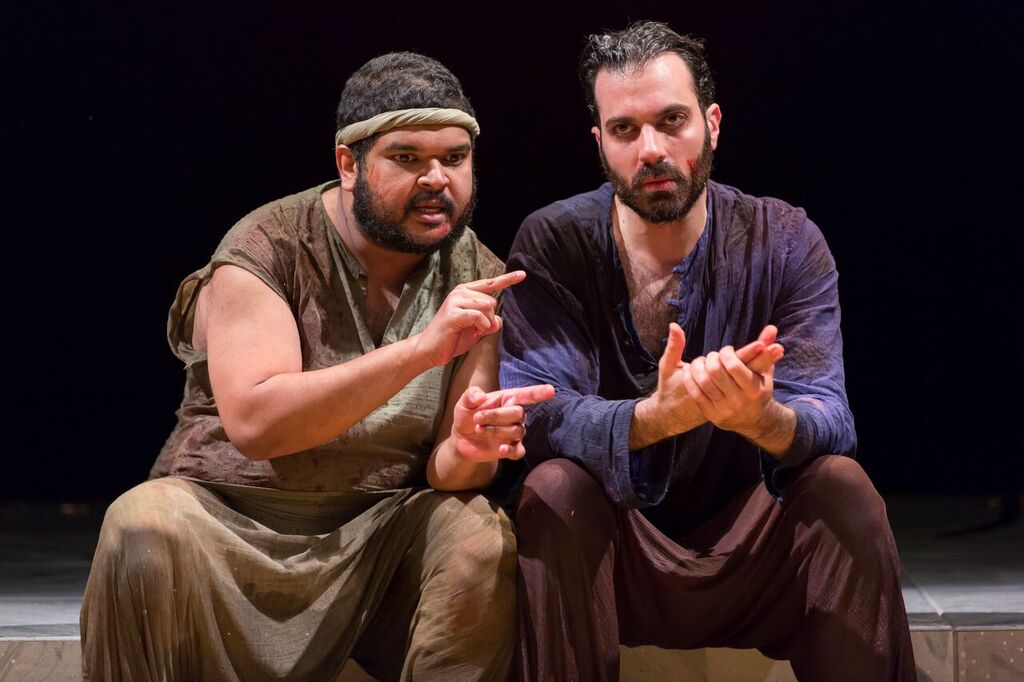 His
friend, Humayun (Ethan Hova), is much more soldier-like; after all, his
father is head of the royal guards, and with any luck Humayun will take
over that position. His
friend, Humayun (Ethan Hova), is much more soldier-like; after all, his
father is head of the royal guards, and with any luck Humayun will take
over that position.Then the unthinkable happens (or, unfortunately, the all too thinkable.) Shah Jahan, the kingdom’s Islamic Emperor, orders the “de-handing” of all the artisans and architects who built the Taj. “Why?” one might ask. Did he find a flaw in his mausoleum’s commemoration to his favorite, recently departed queen? No–just the opposite. The Taj is perfect. The Taj is divine. The Taj is beauty incarnate. And in Shah Jahan’s infinite wisdom, only a fool would want these artisans making anything else that might rival the Taj’s beauty, if only to fall short. Just to be clear: there is no historical evidence that Shah Jahan actually ordered 20,000 artisans to lose their hands. There is rumor only. In order words, there is a legend. Rajiv Joseph brings that legend to life when he has his two ill-fitting guards take up the task of de-handing 20,000 workers. One of the 20th century’s greatest playwrights, Bertolt Brecht, coined the theatrical term Verfremdungseffekt, or alienation effect. The effect is rooted in theatre’s ability to make an emotional event “strange” or distant and, thereby, make it viewable, so as to better understand it. For Brecht, such an effect was necessary if one were going to explore one’s own cultural milieu. A direct approach would meet far too much audience resistance to be received quietly. By taking us to Hindustan and to its empire’s most glorious aesthetic achievement, Woolly’s production of Guards at the Taj takes us into the heart of every person who has stood before the vanity of institution and empire and been told “to follow orders.” 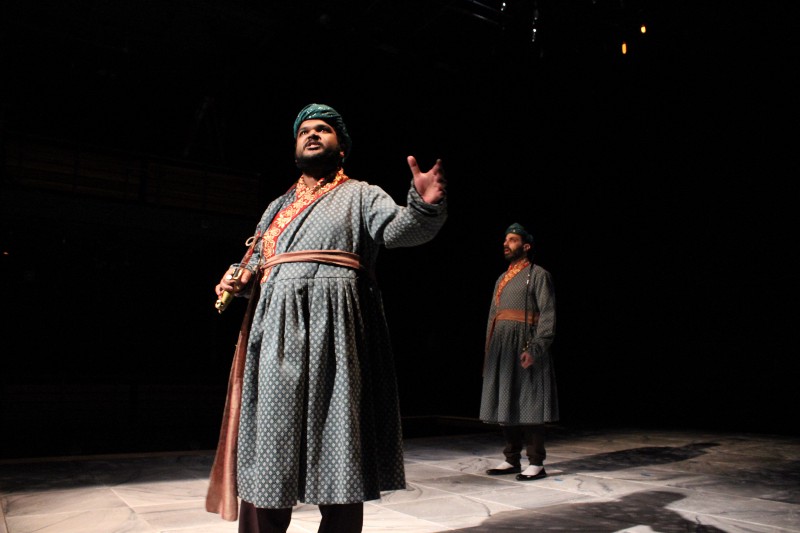 By
playwright Joseph giving them contemporary speech patterns, and
director John Vreeke, 21st century behavioral traits, both actors
resonate with the immediacy of now. By
playwright Joseph giving them contemporary speech patterns, and
director John Vreeke, 21st century behavioral traits, both actors
resonate with the immediacy of now.The duties they perform, and the horrors they commit are as American as Dresden, or Mi Lai, or Flint, Michigan. In this sense, every human rights violation has been carried out by an ordinary human being follow orders. And then some other ordinary person covering up the atrocity. Whether it’s a nation’s evil “other” guy doing the deed or one of our own “good” guys ordering the slaughter, the whimsy of State official power has devastating consequences. Not just for those who suffer the action, but also for those who have to carry it out. For the consequence for disobedience is always high. There are no whistleblower laws strong enough, or enforceable enough, to protect us from the fallout. Woolly’s Guards at the Taj cuts to the bone. Its thrust staging dumps its horror right in the audience’s lap, and it makes no difference if laughs are a part of the show. The action is no laughing matter. The dichotomy of power is clear. The powerful, with their institutions and armies, order and the powerless either carry out those orders or suffer a life unfulfilled. But beauty is clear also, the beauty that lightens the soul and transports the mind to places far way and not nearly so despairing.  Set Designer Misha Kachman, working closely with Lighting Designer Jen Schriever, does not give us the Taj Mahal; for its beauty is not the stuff of dreams. Together, they give us a different kind of beauty. In his famous poem, “Thirteen Ways of Looking at a Blackbird,” Wallace Stevens wrote: I do not know which to prefer, The beauty of inflections Or the beauty of innuendoes, The blackbird whistling Or just after. Innuendoes yes, as we contemplate the Taj, the beauty of its implications abound, but also the beauty of the blackbird, or the flamingo, or the flock, takes hold of us. For we have the imagination to embraces such wonder, and that is the most powerful beauty of all. Review by Robert Michael Oliver DC Theater Arts |
Review by Jayne Blanchard DC Theatre Scene Two actors on an austere stage plus director John Vreeke equal nirvana in Woolly Mammoth’s revelatory production of Rajiv Joseph’s tough, funny, poetic play Guards at the Taj. This is one of those shows that makes you feel lucky to be in D.C. and privy to such gorgeous new plays and productions as this. It’s a hard experience to shake and like one of the characters, you feel as those you’ve fallen into a trance.  The play begins on
the eve of the unveiling of the Taj Mahal, purported to be the most
beautiful building on earth. Two low-level imperial guards Humayun
(Ethan Hova) and Babur (Kenneth De Abrew) stand at the marble entrance
with their backs to the edifice—forbidden to look until sunrise. The play begins on
the eve of the unveiling of the Taj Mahal, purported to be the most
beautiful building on earth. Two low-level imperial guards Humayun
(Ethan Hova) and Babur (Kenneth De Abrew) stand at the marble entrance
with their backs to the edifice—forbidden to look until sunrise.But really, wouldn’t you want to sneak a peek? Humayun, the pedant of the pair, tries to follow orders but is cajoled by the more jovial and loose Babur to disobey orders. In the comic, clown-like exchanges that remind you of a South Asian version of Waiting for Godot, the two swap secrets and gossip about the construction of the Taj Mahal and you are lulled by the easygoing banter that you find between lifelong friends. Humayun is the duty-bound rule-follower, all tied up with trying to prove his worth to his career military father and almost absurd in his loyalty to the ruler Shah Jahan. Babur is the philosopher and dreamer, seemingly a goof-off but someone whose imaginary inventions include the flying machine equipped with seat belts. You really cannot find a more potent and true pairing as Hova and De Abrew, who portray the realist and the idealist, the straight man and the comic foil, with such openness and poise you feel like you are eavesdropping undetected on a private conversation.  Their glimpse of the
Taj Mahal dazzles both them and us. This look at unparalleled beauty
gives the second part of the play a searing brutality as they are
commanded to defend this beauty from any possible rivals through
unspeakable acts. Their glimpse of the
Taj Mahal dazzles both them and us. This look at unparalleled beauty
gives the second part of the play a searing brutality as they are
commanded to defend this beauty from any possible rivals through
unspeakable acts.From the dream-like quiet of the first part, we move to an intense interior scene, an abattoir of sorts set up in the shadows of the Taj Mahal, which was built as a mausoleum and tribute to the Shah’s favorite wife, the late Empress Mumtaz Mahal. As they stumble around the filthy room, disheveled and disoriented, they try to piece together what they just did. Humayun insists they just did their job and tries to convince the increasingly undone Babur to cope. Babur, true to his metaphysical nature, is convinced they ruined something pure and nothing will ever be right again. Where Humayun sees rigid obeisance to duty, Babur envisions rebellion. “Stop thinking. Stop talking.” Humayun soothes, washing and dressing the dazed Babur like he’s a baby. The placid loveliness of the earlier scene has turned into a chamber of horrors as we watch Humayun and Babur become the latest victims of the Shah’s cruel caprices. The play delves into how the push and pull of good friends can be both sustaining and a prison. It also speaks to the high human toll paid throughout history (think the pyramids, the Parthenon, Great Wall of China and other majestic structures) for the wonders of the world—that were built by the wealthy but ultimately enjoyed by all. What price beauty? What price friendship? These timeless questions are explored—but not answered—in Joseph’s devastating play about two lowly men passing the time who get caught up in something much bigger than themselves—and more tragic. Review by Jayne Blanchard DC Theatre Scene |
Guards at the Taj demonstrates an inevitable societal truth; horrific things happen alongside magnificent things Review by Jennifer Minich MD Theatre Guide Set in 1648 in Agra, India, Guards at the Taj unfolds on the eve of the unveiling of the Taj Mahal. A two-man production, Guards at the Taj tells the tale of imperial guards (Kenneth De Abrew) and Humayun (Ethan Hova). Historical fiction and modern jargon converge onstage in this dark fairytale resonant of the genre of magical realism.  Playwright Rajiv
Joseph captures a beautiful and appalling moment in Indian history and
imbibes it with humanity. Bird lovers, amateur architects, and
inventors Babur and Humayun witness the first sun rise over the Taj
Mahal. The lowest of the low, their joy is short lived and their next
task is incongruously horrific and bloody. Their hands become caked
with the blood of others and they must decide how to move forward in
their lives and their friendship. Playwright Rajiv
Joseph captures a beautiful and appalling moment in Indian history and
imbibes it with humanity. Bird lovers, amateur architects, and
inventors Babur and Humayun witness the first sun rise over the Taj
Mahal. The lowest of the low, their joy is short lived and their next
task is incongruously horrific and bloody. Their hands become caked
with the blood of others and they must decide how to move forward in
their lives and their friendship.Historically retrospective, Babur and Humayun’s struggles are no less far-fetched for Woolly Mammoth’s audience. Guards at the Taj demonstrates an inevitable societal truth; horrific things happen alongside magnificent things. The consequences and their justifications are timeless. In the dog-eat-dog world of the nation’s capital, where friendship often comes second to your political affiliation or allegiance to your tax bracket, Babur and Humayun’s life and death struggles are a dramatic interpretation of the complexities of friendship, responsibility, and beauty.  Humayun is grounded
in harsh reality while Babur is a certified dreamer. They each
represent rival and enduring aspects of society. Relatable and
affable, Babur and Humayun navigate their friendship within the
confines of societal restrictions. Hova and De Abrew confidently carry
this rather physically demanding performance. In the hands of these two
charismatic actors, Guards at the Taj becomes fluid and spatially
abstract. Invisible flamingos can be seen flying overhead and the dark,
dense forest teems with colorful life. Humayun is grounded
in harsh reality while Babur is a certified dreamer. They each
represent rival and enduring aspects of society. Relatable and
affable, Babur and Humayun navigate their friendship within the
confines of societal restrictions. Hova and De Abrew confidently carry
this rather physically demanding performance. In the hands of these two
charismatic actors, Guards at the Taj becomes fluid and spatially
abstract. Invisible flamingos can be seen flying overhead and the dark,
dense forest teems with colorful life.Director John Vreeke’s production team actively engages with his audiences’ imagination. Set Designer Misha Kachman’s set is sparse, featuring a clean marble floor with bloody lower room revealed underneath. For this production the Woolly Mammoth stage is upended from its tradition post and extended into midst of the audience. The outcome is a physically intrusive dramatization on the dichotomy of dark and light. Lighting Designer Jen Schriever and Sound Designer Palmer Hefferan’s innovative designs overwhelm the senses and generate suspense and awe. Although there is no intermission, a creative strategy which I generally loathe, Guards at the Taj is cohesive, swift, dreamy, and smart. Guards at the Taj is also rioutously funny, so please don’t think it is all doom and gloom. Review by Jennifer Minich MD Theatre Guide |
 Winning performances
highlight Woolly Mammoth's darkly tragic period drama
Review by Chris Klimek The bickering of the empire’s lowliest servants is a subject rich in dramatic provenance, from Kurosawa to Beckett to Stoppard to George Lucas to Kevin Smith. Rajiv Joseph—the American playwright whose 2009 drama A Bengal Tiger at the Baghdad Zoo was a finalist for the Pulitzer Prize—is the latest to find inspiration in the canon of cannon fodder, fashioning a haunting and universal fable from a tale of two soldiers whose duties resemble those of innumerable soldiers throughout history: Long stretches of tedium punctuated by a life-altering episode of unfathomable horror.  As you might infer,
the setting for Joseph’s magnificent Guards at the Taj is the Indian
city of Agra in the mid-17th century. The Taj Mahal, Emperor Shah
Jahan’s grand, ivory-hued mausoleum for his favorite wife, is nearing
completion after 16 years of construction. Humayun and Babur aren’t so
much watchmen stationed there as they are the least of its
architectural features, forbidden even to turn around and steal a
glance at the magnificent edifice. Of course, they’re not supposed to
speak, either, but they do—in the vulgar patois of 21st-century
American English, no less. It’s a testament to the emperor’s
unchallenged dominion that he entrusts his security to this pair of
bumblers. As you might infer,
the setting for Joseph’s magnificent Guards at the Taj is the Indian
city of Agra in the mid-17th century. The Taj Mahal, Emperor Shah
Jahan’s grand, ivory-hued mausoleum for his favorite wife, is nearing
completion after 16 years of construction. Humayun and Babur aren’t so
much watchmen stationed there as they are the least of its
architectural features, forbidden even to turn around and steal a
glance at the magnificent edifice. Of course, they’re not supposed to
speak, either, but they do—in the vulgar patois of 21st-century
American English, no less. It’s a testament to the emperor’s
unchallenged dominion that he entrusts his security to this pair of
bumblers.Humayun (Ethan Hova), the son of a minor government official, is sufficiently cowed that he would likely obey his orders forever if not for the influence of chatty, immature Babur (Kenneth De Abrew). Babur passes the long hours standing post by imagining fantastic inventions: Cloud Tea, a Transportable Hole, and a machine as bizarre as either of those things that he struggles to describe. We would call it an airplane. When Babur daydreams aloud of being assigned to guard the emperor’s harem, Humayun is quick to pop his balloon: “It’s a government department,” he shrugs. Pragmatism aside, Humayun and Babur have heard the same legends about the Taj Mahal that we have. There’s no historical evidence that Shah Jahan actually mutilated the thousands who worked on the grand building to prevent them from replicating their creation, for example, but stories like this preserve the social order. If the Indians starving in the provinces ever collectively decided they don’t like suffering so their rulers can live lavishly, there wouldn’t be enough Imperial Guards to kill them all. It’s this seditious strain of thinking that the idleness of Humayun and Babur’s assignment enables. The refusal of the imagination to lie dormant even when one’s station in life makes no accommodation for it is the animating tragedy of Joseph’s sublime script. Few stories are as sad as when an unwitting prisoner first perceives the bars of his cage. Hova and De Abrew both let us see that gradual awakening, and their struggle to keep their rebellious speculations in check, without ever coming off as maudlin or detached. They’re perfectly calibrated performances. Director John Vreeke’s design team has wisely taken a minimalist approach to suggesting the presence of one of the world’s most famous buildings. Misha Kachman’s set is largely bare, though the floor opens up into a pit for one grisly interlude. Sound designer Palmer Hefferan and lightning designer Jen Schriever both use subtle tonal effects to keep the emotional palette calm even when the business at hand is dire, making the whole thing feel like a dream. Six years ago at Woolly, Vreeke staged an earlier Joseph two-hander, Gruesome Playground Injuries. That show, tracing a 30-year romance via its two participants’ periodic visits to the emergency room, bled at least somewhat into reality when its two cast members, Gabriela Fernandez-Coffey and Tim Getman, chose to marry. I hope I’m not giving too much away by saying it would be a tragedy if Hova and De Abrew’s fates followed those of their characters quite so closely. Review by Chris Klimek Washington City Paper |
|
Idealism Meets Reality in Woolly Mammoth's GUARDS AT THE TAJ The
character development
is exceptional. Combined with De Abrew and Hova's outstanding
performances and John Vreeke's solid direction, Woolly has delivered a
stellar production.
Review by Benjamin Tomchik BroadwayWorld.com If you were guarding the most beautiful thing on earth but could not look at it, would you try to sneak a peek anyway? Taking the situation a step further, what if you were ordered to do the unthinkable to the very hands that created such beauty, would you follow thru? This is the opening predicament of Woolly Mammoth's philosophical Guards at the Taj. Flawlessly performed by Ethan Hova and Kenneth De Abrew, Rajiv Joseph's play uses India's most iconic landmark, the Taj Mahal, as the backdrop for an exploration, between friends, of beauty in both the ideal and real world.  It's the eve before the unveiling of
the Taj Mahal and imperial soldiers Humayun (Hova) and Babur (De Abrew)
are standing guard, clad in Frank Labovitz's elegant teal guardsman
costumes, with their backs against the monument. Ordered not to look,
they engage in a vigorous debate about whether or not to do so, and
trade many rumors accompanying its construction. When Emperor Shah
Jahan decrees that nothing as beautiful as the Taj Mahal is ever to be
built again, the two lifelong friends and soldiers are left with the
gruesome task of enforcing his order. It's the eve before the unveiling of
the Taj Mahal and imperial soldiers Humayun (Hova) and Babur (De Abrew)
are standing guard, clad in Frank Labovitz's elegant teal guardsman
costumes, with their backs against the monument. Ordered not to look,
they engage in a vigorous debate about whether or not to do so, and
trade many rumors accompanying its construction. When Emperor Shah
Jahan decrees that nothing as beautiful as the Taj Mahal is ever to be
built again, the two lifelong friends and soldiers are left with the
gruesome task of enforcing his order.Joseph's play is complex and will have you leaving Woolly pondering its various themes. It has elements of dark humor and satire intermingled with ghastly situations that put the virtues of beauty and friendship on trial. At times, Joseph's script meanders causing the second and third scenes to become a tad monotonous, before finishing strong. It features a mix of modern language and imperial-sounding English that at times can be off-putting, but is always humorous. The character development is exceptional. Combined with De Abrew and Hova's outstanding performances and John Vreeke's solid direction, Woolly has delivered a stellar production. The importance and strength of the chemistry between De Abrew and Hova cannot be understated. This is a two-man play, with the production resting on their shoulders. Their friendship at times comes off like a Martin and Lewis routine with Hova the straight man to De Abrew's humor, with the interaction building up to an impactful climax at the end of the play. De Abrew portrays Babur as a dreamer, someone whose idealism was not striped away in his military training. Always thinking up inventions, he sees the world in a philosophical light. In contrast is Hova's straight-laced Humayun, seeking to gain his father's approval and live up to the family's military heritage. Together they provide the perfect counterbalance, like most great friendships, while fueling dreams and attempting to cope with the reality that unfolds before them. Misha Kachman's production design doesn't reproduce the grand mausoleum and chooses instead to quite successfully convey elements of its design. A tainted white faux-marble covers the floor, with a black cloth against the wall. Jen Schriever's innovative lighting design incorporates scattered twinkle lights to create the night sky before giving way to waves of white light at the Taj Mahal's unveiling. When the action then moves to the palaces seedier outposts, Kachman's design creates a dungeon of nightmares. Watching Guards at the Taj, you can't help but notice that the philosophical debate between the two guards is still ongoing in various facets of society - that of the idealist versus the realist, struggling to find common ground. That's what makes this a thought-provoking production and Joseph's words incredibly powerful. Review by Benjamin Tomchik BroadwayWorld.com |
|
|
|
|
| INTERVIEW: |
 Interview by Alan Katz February 5, 2016 Rajiv Joseph’s Guards at the Taj talk extreme beauty & extreme violence Plays about extreme Beauty always seem to contain extreme ugliness. Woolly Mammoth’s newest offering, the off-Broadway smash and award-winning straight play Guards at the Taj, is no exception. Described alternately by Woolly’s cast as “A play that takes place in Agra the day the Taj Mahal is going to open where two guards who are childhood friends are assigned a gruesome task and that task changes their relationship” and “A comedy about best friends who are trying to survive while doing horrible things.” The play is simultaneously buddy comedy and disturbing drama, so I wanted to sit down with Kenneth de Abrew and Ethan Hova, who form the entire cast of this two hander, to see how they deal with the extremes of the play. Along the way, I got a peek into what it is like to be a Brown actor, Rajiv Joseph’s poetry, and how 17th century Agra is like 21st century DC. Alan Katz: How did you both come to be involved with Guards at the Taj? Ethan Hova: As soon as the script was made available in American Theater Magazine, I read it and loved it. As soon as came it up, I jumped on the chance to audition for the play. Kenneth de Abrew: I had heard about the play, but it wasn’t until I read it that I said, “Yeah, I gotta have this role.” EH: One of the things about being an actor who is, well, brown (I’m half Arab and Kenneth is Sri Lankan) is that almost all the roles that I go out for because of my ethnicity in some way have accents; they’re painted as Other. Rajiv goes to great lengths to not do that. These characters speak colloquially, just like you and me. I just don’t get that opportunity as an actor. I’m usually running around in a suicide vest with a machine gun. KdA: [laughing] And I’m a taxi driver! EH: This opportunity is special and really really rare. KdA: The way people speak is important. I have a very special [South Asian] dialect. The script specified that the actors had no accent, so we wondered if that meant that I should speak in Standard American. But Rajiv said, “No. Speak the way you speak. First of all, this play is set in Hindustan in 1648. They didn’t speak English. Second, what would something speaking with their accent sound like?” We don’t know. So, don’t have to “put anything on.” I speak the way I speak. But that’s not the only thing. As an actor, you want to work in general, up for any challenge. But it is rare to look at a script and say, “That feels like it was written for me!” The friendship between Humayun and Babur draws me to this particular role. I’m still friends with a guy who I’ve known since I was 6 or 7, and we have this brotherly friend relationship, the kind who would tell me to tuck my shirt in when we were teenagers. This is the start of Humayun and Babur. Humayun is maybe a little more mature, he has an understanding of how systems work. Meanwhile, Babur is more out there. Which is like me, so that was appealing. EH: Same here. Humayun could not be written to match more closely what I do well. I enjoy playing the serious clown, the kind of character that you like seeing fall down. The William H. Macey from Fargo type. That’s what I saw in Humayun, the kind of character who trying so hard to follow the rules and be rigidly serious that you laugh at him when he eventually does fall down. That’s the fun of him, but he’s also vulnerable and sensitive. Humayun and Babur seem much like a double act comedy team, so very funny, but it’s also not a funny play. KdA: Yes to both! EH: You laugh when you cry and cry when you laugh. And when you look at great playwrights, the real geniuses, they’re able to do that. Chekhov did that, and Rajiv Joseph can do that. KdA: There’s a lot of quick switching that goes along with that comedy team dynamic. There are times when Humayun is driving the scene, sometimes when Babur is driving it. But that change can turn on a dime. It keeps our exchanges very active. Your characters go through such extremes of both emotional and physical distress. The horrible task you are assigned is so extreme, it’s difficult to imagine doing what you do. How do you bring that into reality on a stage, emotionally? EH: For me, I rely on the text. When you read the text, it isn’t entirely in prose like you might expect. Parts of it are written in verse. Rajiv makes liberal use of carriage returns and punctuation to create poetry. So when I sit down to read the script, if I respect the paragraphing and punctuation, it will have an emotional effect just because of how he has structured the breaths and sentence lengths. That’s why the man is a genius, and why I’ve just put all my faith in the text. Let it be honest. I actually didn’t and couldn’t look into the emotions of the piece until we started running it as a whole. Each scene feeds perfectly into the next, so you need to build that momentum in rehearsal. KdA: I grew up in Sri Lanka, which is a country that was in a civil war for many years. And while the violence didn’t happen in front of me all the time, there were plenty of suicide bombs and terrorist attacks. So there is a certain tension that I’m used to, in a sad, but in a very practical way. It was a very real possibility that you could get caught up in something and your life would end. I didn’t grow up in a war zone; it was just that these things would happen. So that is something I recognized in this play. What about the other extreme? Guards at the Taj is as much about beauty as it is about violence. There’s this gorgeous moment when you see the Taj for the first time. Since neither of you has actually been to the Taj, especially when it first opened, what do you use to inhabit that transcendent moment of Beauty? EH: It’s different for me every night. Sometimes, and this will sound silly, it’s just seeing a flap of fabric moving. Sometimes it will be a specific memory. That’s worked so far. Knock on would it keeps working. KdA: I was in India this past Thanksgiving, and while I didn’t get a chance to go to Agra, my father who has been to the Taj Mahal would help me. He would point out designs as we went to shops, and say, “It’s like this. But way better.” So I have that, something small. But there’s another idea. I talk about flying in the play, how it makes us and everything we know look so small, and then when I see the Taj, that magically becomes real. So that’s how you approach the show emotionally, but what about physicality? EH: The play places wonderful restrictions on the acting and the staging physically. The first scene is long, almost a third of the play, and throughout it we aren’t allowed to turn around or move from our post. So every move that you make has to be meaningful, especially in those scenes. So we had to find the right and only moments when we could let our guard down. When we’re not guarding, I mostly think of Humayun moving in straight lines and turning at right angles. Not the same for Babur though. KdA: [laughing] No, no, I was thinking just the opposite. I always think about rounds and amorphous shapes. Another thing we did was start out with a bunch of movement. John [Vreeke, Director] would have us be moving around and we were acting almost as if the Taj wasn’t there.But throughout the process, we pulled back. So, all that work is still there in our bodies and in our [vocal] text. But now we can’t move because, well, we can’t move. Even as adventurous as Babur is, he won’t just move. And, of course, I’ve got to get Humayun to move. Agra is a capital city, a center of power. With this giant dome under construction in the middle of it. What’s it like to perform that play in a capital city, a center of power. With this giant dome under construction in the middle of it? EH: I hadn’t made that connection until now. I’ve had very specific reactions to being in DC (this is my first time as an adult. It feels so different from every other city of its size in that things happen here that are relevant, of great import around the world. And for our characters, we’re living in what is, to us, the most important city in the world. KdA: In the apartment complex where we’re staying, there’s a TV in the lobby. When there’s a football game on, there’s really nobody there. But when there’s a debate on, there’s people. Average people get in on it. EH: I’ve been thinking about audiences for our show. So much of our play deals with the responsibility of having power and privilege, being close to the center. In that respect, we’re doing this play in the perfect city if we can get the right people to come see it. I really hope people in power come see this play because it is meant for them. KdA: I think the military community could benefit, too. PTSD and what happens after something terrible happens are big themes in this play. In the world of Agra, you’re supposed to move on like [snaps] that. Can you really? That’s a potent and important question. People are so concerned with the war, who wins and who loses, but don’t think about what happens after. I think we live in a society and a world where there is no more “after the war.” EH: How do you cope with that? How do deal with that on a daily basis? Do you ignore it? Try to move on? These are all valid questions. Interview by Alan Katz DC Theatre Scene |
 RETURN TO MAIN PAGE - JohnVreeke.com |



